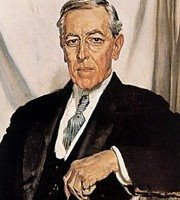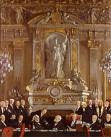
Well, the nineteenth of January passed with nary a mention in this blog that the German election took place. This was of course the election for a Constituent (constitution-making) Assembly. From this vantage point, I want to go over some basics.
Please remember that there was a German Revolution that began in November, that the moderate Socialists (the SPD) and the smaller party of leftist Socialists (the USPD) took over the reigns of government.
The two parties were really very different. The mainstream SPD was a socialist party which officially recognized Marxism as its basis, but which had, since the 1890s moved much closer to the mainstream. The leaders of the party, like Friedrich Ebert and Philipp Scheidemann, had the political views of, roughly, an American liberal of the late twentieth century: pro-welfare state, conditionally pro-national defense, against teaching religion much in the schools, devoted to centralized government. Additionally, most of the SPD members were very much opposed to the continued special position of the titled nobility of the German Reich (really a federal league of German states). On the other hand, most of these mainstream socialists were probably more or less willing to allow the monarchy to stay on, much the same way that the British Labour Party has never argued against the British monarchy with much energy.
The Independents, on the other hand, were much more devoted to a strict Marxian analysis. Many of them had been extremely active in international socialism and were well acquainted with Lenin, the Bolsheviks, and other leftist European socialist parties. They were in favor of a Marxist republic. They were not necessarily ready to outlaw all property, but certainly, they wanted all industry and all banks (Lenin's "commanding heights" to be confiscated by the state. Many of the Independents had more than a bit of anarchism in them, however, and this represented an inherent conflict: the anarchists wanted the factories, towns, and communities to be run by local "councils" or some other local organs existing from the people; but other Independents were "democratic centralists" very much in tune with the Bolsheviks.
There was one more party that emerged in mid-November that actually weakened the Independents by drawing off their membership: the Spartacists, or the Spartacus League. Named after the leader of the great Roman slave revolt, the Spartacists were essentially the German socialist party most in tune with Lenin and the Bolsheviks on the issue of revolutionary tactics and the violent overthrow of parliamentary, bourgeois government. It was founded during the war as a radical protest of the war itself. By the middle of December 1918, the party was calling itself the German Communist Party. It was led by Karl Liebknecht and Rosa Luxemburg. Liebknecht was a firebrand radical socialist attorney. Luxemburg was a 47-year-old professional revolutionary. She was born in Russian Poland to a Jewish family, and she joined the socialist movement from the time it was founded. She was a prolific organizer and writer, and was one of the most prominent supporters of violent, revolutionary Marxism.
In any case, of these gaps within the German socialist movement, the widest gap was between the SPD and the USPD/Spartacist end of the spectrum, and over December, with revolution in the streets, the gap widened. As it did so, the mainstream SPD leaders decided to shake off the USPD and align itself with the forces of order: in particular, the army. Actually, Friedrich Ebert knew Ludendorff's replacement as Quartermaster General, Wilhelm Gröner, and the two spoke almost at the beginning of the Revolution. Gröner agreed to support the new Republic, and Ebert agreed to a very moderate revolution.
Hence, when the Spartacists tried to revolt and overthrow the socialist regime in early January, before the election for the Constituent Assembly, the Ebert/Scheidemann government called for its own volunteers, and the German army raised volunteer groups as well to put down the revolt—with much awful violence all around. Karl Liebknecht and Rosa Luxemburg were both executed while in "custody" of the volunteer (Freikorps) forces of order on January 15, Luxemburg in an especially brutal way that left her body floating in the Landwehr Canal in Berlin. Hundreds of revolutionaries died, and not a few of those fighting against them. These battles were still raging was the election took place.
No surprise then that the National Constituent Assembly that was elected (by universal adult suffrage) was not exactly a vote of confidence for the Revolution. Here is the result:
USPD (the Independents)—7.6 %
SPD—37.9%
DDP (a moderate liberal party)—18.5%
Zentrum/Center (the Catholic party)—19.7
DVP (a conservative, business-oriented party)—4.4%
DNVP (a right-wing, nationalist party)—10.3%
other parties—1.6%
So the mainstream SPD won big. The Communists refused to participate (they wanted to overthrow the government, not be elected to positions in it), so the radical vote was actually paired down as a result. The radical Independents only won 7.6%. Granted, some kind of socialists won 45.5% of the vote, but still not a majority (and about the same as the same group had been polling before the war).
What is equally important, the percentage of the vote that went to parties officially recognizing and declaring themselves loyal to the Republic (as opposed to some future restoration of monarchy) was really quite strong: calculated cautiously, at least 75%.
The idea was to meet to deliberate in some quiet place (not violent Berlin, for goodness sake—they had all read about the French Revolution!). They chose the old Saxon city of Weimar, a part-day train ride from Berlin. It was after all the center of classical German culture (Bach, Goethe, Schiller, Herder, etc.). It also—as the cabinet officials working on this took into special consideration—also had a large City Theater which could seat the 500 plus delegates. So Weimar prepared for the arrival of the parliament, the Communists and other radical revolutionaries poured on the pressure to disrupt as much as possible before the assembly could gather in Weimar, and a wide variety of German politicians, bureaucrats, and scholars thought long and hard about what kind of constitution to create for the new German republic.
Please remember, with the Allied Blockade still operative, all of this took place against a background of shortages, inflation (not hyper-inflation yet), and above all hunger.













